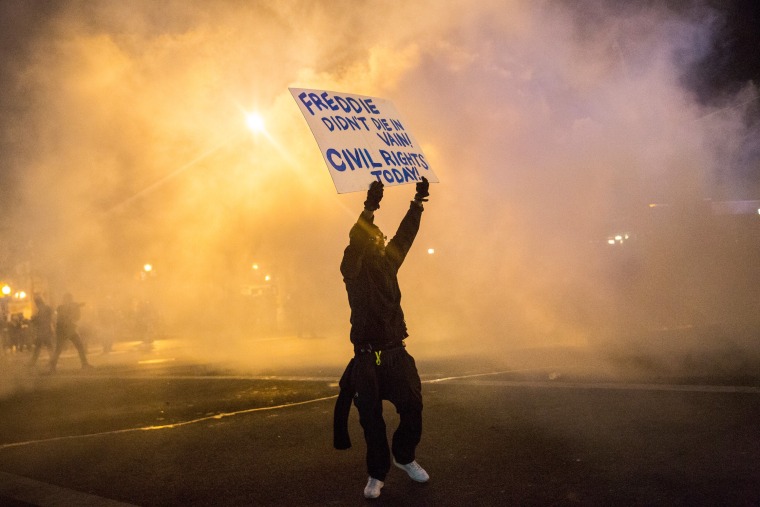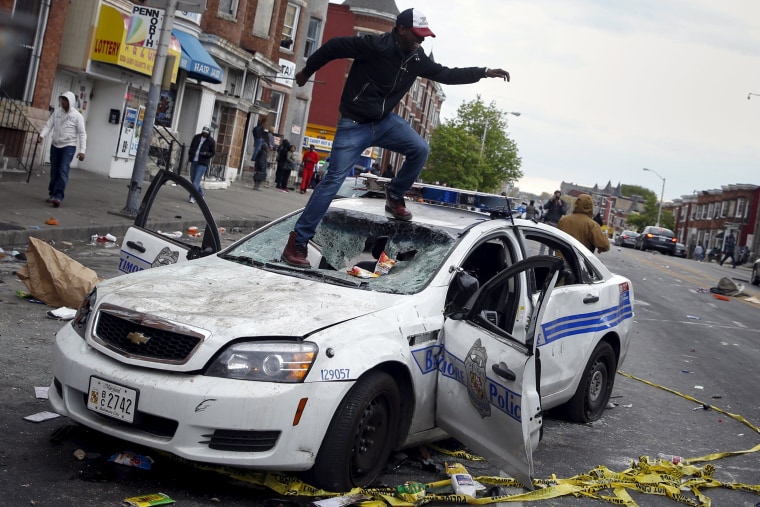While Americans have been glued to their TVs, laptops and Twitter watching riots and protests against police brutality over the last 8 months, the majority of the country remains spectators not participants. Millions of Americans watch the events in Ferguson and Baltimore like high-school kids at the opera. You know it’s important, and you should be paying attention, but you really don’t understand what you’re looking at.
Our only frame of reference for today’s events are black and white videos of protests in the 1960’s, but today’s 24-hour news cycle, social media and streaming makes current riots and protests a lot harder to process. Fortunately it doesn’t have to be that way, you can as an outsider observe what is going on now in Baltimore (and likely other cities soon) and come away informed and educated instead of confused and depressed. There are five easy steps on how to watch an American riot.

1. Switch Channels
What you may see on CNN, or MSNBC, or Al Jazeera or Fox or Bloomberg will differ immensely and if you’re actually interested in understanding what is happening on the ground you need to hear and see as many perspectives as possible. And if you can, watch local news as well, live streams from St. Louis, Baltimore brought perspective to the events on the ground that the national news completely missed.
2. Follow the Right People
On Facebook, and Twitter in particular it’s very easy to simply follow the hashtag #Baltimore or #BlackLivesMatter and get led down a rabbit hole of screaming opinionators, who oftentimes are nowhere near the events they’re pontificating about. Instead of giving them new followers, follow local reporters, police departments and civic organizations on the ground. You’ll get better explanations for everything from burning buildings to school closings long before national pundits looking to make a splash reframe everything to their liking.
3. Geography Matters
Claustrophobic camera angles, running reporters and close ups of burning buildings make every riot or protest look like the sack of Rome and every police to protester interaction look like the No Church in the Wild video. In most cases protests and riots are fairly regional affairs. In Ferguson three blocks over from a bombed out McDonald’s on West Florissant Street people were sipping coffee and buying groceries. Despite police and protesters near Camden Yards in Baltimore the Harbor was fine. To actually watch these riots occur, pull up Google maps and learn where the locations of protest and coverage are. Oftentimes you’ll realize that the circumstances on the ground aren’t nearly as dire as what you’ve read or seen.
4. Recognize you’re watching History
Do you know that there have been three major political riots in Baltimore history before the Freddie Gray protests? ( 1812, 1861, and 1968). In other words while what you are seeing now is history in the making it doesn’t mean that every event is ‘historic’. The riots in Baltimore, Ferguson and likely other cities to follow may seem significant now but will look very different through the lens of history. Consequently resist the temptation to explain what all of this “MEANS” in the moment, or let anyone else on television or in print give you some grandiose theory. 50 years ago America looked like it was getting torn apart by revolution and war protests and now we just call that the “Civil Rights” movement.
5. All Politics Is Local
While it’s convention to mutter “Why are they destroying their own neighborhood” when watching riots from a distance remember that local politics explain riots much more than pithy explanations. In Baltimore the police have a special “Bill of Rights” specifically designed to frustrate investigations like the one needed to explain what happened to Freddie Gray. (Which explains why NONE of the police involved in Gray’s death have been interviewed yet).
Consider that Mayor Stephanie Rawlings–Blake vetoed a bill that would’ve required officers to wear body cameras just last December, or that the city of Baltimore has shelled out over 5.7 million dollars since 2011 in settlements over police brutality. When you add up these local political events, combined with the egregious levels of poverty in the West Baltimore neighborhood where Gray was killed a lot of what is being destroyed doesn’t ‘belong’ to anyone living there. And further, as President Obama pointed out , there were thousands of protesters all weekend in Baltimore that got little or no coverage, but the moment a CVS caught on fire the news descended on the city like it was a live re-enactment of Mad Max.
To Conclude Our Lesson...
Hopefully most Americans will never have to live first hand through the fear, anger and community frustration that leads to a riot or public uprising. But just because we may not be experiencing it directly these events are a part of our country and we are forming policy beliefs, notions of empathy and visions of America based on how we consume riot coverage.
If you follow the five steps above, you just might learn something while this tragic violence is occurring. And hopefully when the next riot happens, you’ll know be better prepared to tune out the shaky camera angles and disconcerting ranters on social media.

